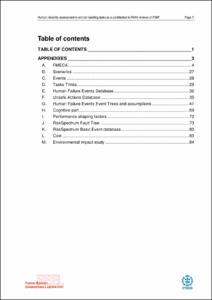Mostra el registre d'ítem simple
Human reliability assessment in remote handling tasks as a contribution to RAMI reviews of IFMIF
| dc.contributor | Dies Llovera, Javier |
| dc.contributor.author | Baeza Pérez, Eduard |
| dc.contributor.other | Universitat Politècnica de Catalunya. Departament de Física i Enginyeria Nuclear |
| dc.date.accessioned | 2014-03-14T12:53:58Z |
| dc.date.available | 2014-03-14T12:53:58Z |
| dc.date.issued | 2013-05 |
| dc.identifier.uri | http://hdl.handle.net/2099.1/20942 |
| dc.description | Premi al millor Projecte de Fi de Carrera presentat durant l'any 2013 en l'àmbit de Nuclear que atorga la CÀTEDRA ARGOS |
| dc.description.abstract | The International Fusion Materials Irradiation Facility (IFMIF) is a high energy neutron irradiation facility which generates a 14MeV neutron flux with D–Li (Deuterium-Lithium) stripping reactions. It’s an international research project designed to test materials specimens since this environmental conditions recreate nuclear fusion power plants atmosphere. Therefore, the achieved materials database will be utilized to build the inner walls, the blanket components, the coating and the isolation of these future power plants. An overall availability of 70% is required by IFMIF to guarantee the proper materials irradiation; therefore the Reliability, Availability, Maintenance and Inspectionability (RAMI) analyses are necessary in the run up to IFMIF construction. These analyses are carried out by the Nuclear Engineering Research Group (NERG) in cooperation with CIEMAT. Specifically, the following project focuses in the Remote Handling (RH) system used in the test and the target maintenance tasks. The staff cannot have access to this area owing to the effective dose exceeds the minimum hand maintenance zone (650μSv/year) due to the activation of structural materials. Human influence will be an essential factor in these maintenance chores; for this reason, this project is a first milestone towards the merge between RAMI and Human Reliability Assessment (HRA). The Human Cognitive Reliability (HCR) model is the means of quantifying the cognitive part influence in the Human Failure Event (HFEs) while Technique for Human Error Rate Prediction (THERP) is used for the assessment of the action part. The combination of those methods is called Systematic Human Action Reliability Procedure (SHARP) and it will provide us the tool in order to introduce the human factor in the RAMI analyses as a basic event. The report shows the strong human factor influence in the RH tasks and, consequently, the need to develop a tool which quantifies these effects. Moreover, some conceptual improvements of the final equipment design are introduced in those operations or HFEs that induce a high level of unavailability. Some of these recommendations are the implementation of instrumentation in the RH attachment tool or clamp, the implementation of an infrared camera in the cranes or a virtual confinement volume generated by control software integrated in the RH where the operator actuates. Finally, once all the improvements are taken into account, the mean availability exceeds the objective value in the availability allocation of 99.1% during the RH operations: for curative interventions is 99.3% and for the long maintenance period is 95.8%. |
| dc.language.iso | eng |
| dc.publisher | Universitat Politècnica de Catalunya |
| dc.rights | Attribution-NonCommercial-NoDerivs 3.0 Spain |
| dc.rights.uri | http://creativecommons.org/licenses/by-nc-nd/3.0/es/ |
| dc.subject | Àrees temàtiques de la UPC::Energies::Energia nuclear |
| dc.subject.lcsh | Nuclear power plants -- Materials |
| dc.title | Human reliability assessment in remote handling tasks as a contribution to RAMI reviews of IFMIF |
| dc.type | Master thesis (pre-Bologna period) |
| dc.subject.lemac | Centrals nuclears -- Materials |
| dc.description.awardwinning | Award-winning |
| dc.rights.access | Open Access |
| dc.audience.educationlevel | Estudis de primer/segon cicle |
| dc.audience.mediator | Escola Tècnica Superior d'Enginyeria Industrial de Barcelona |
| dc.audience.degree | ENGINYERIA INDUSTRIAL (Pla 1994) |
Fitxers d'aquest items
Aquest ítem apareix a les col·leccions següents
-
Enginyeria Industrial (Pla 1994) [3.410]



